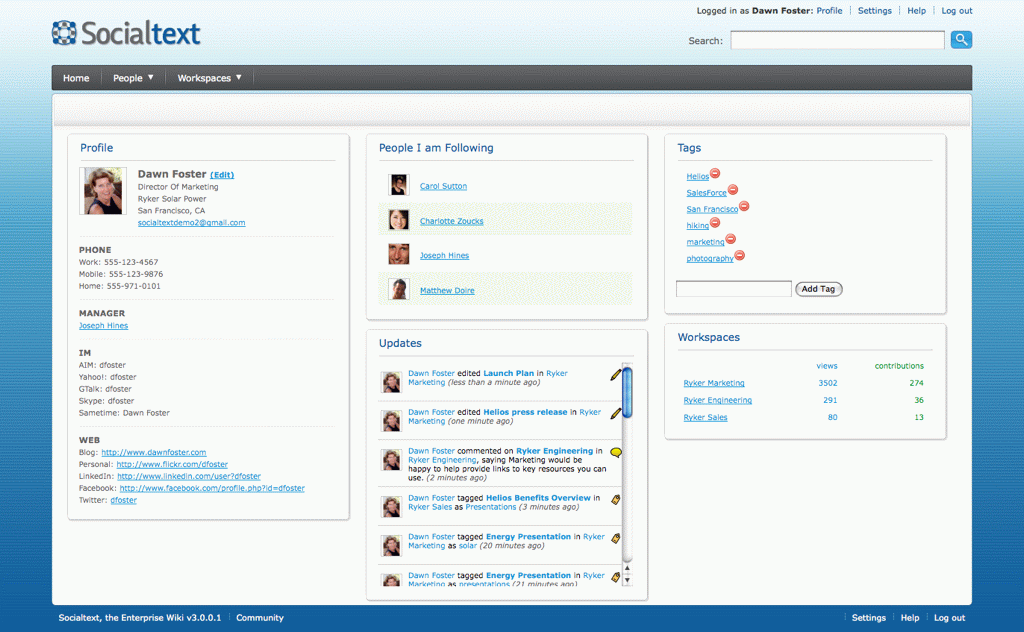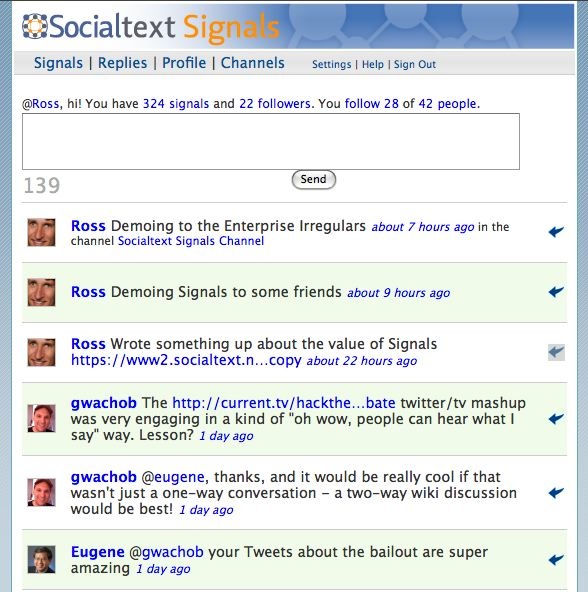SocialText 3.0 is (or will be in the near term) an enterprise mashup of Facebook, FriendFeed, enterprise microblogging, and the wiki. If you were to take any one of these constituencies – social networking, conversation aggregation, Tw*tter, or vanilla wikis and the leveraged sites the technology has produced – you might not think of SocialText as a major player or competitor with the exception of the enterprise wiki space. But add these together and get out ahead of both the market and the logical expansion plans of larger players, and SocialText 3.0 may have something hard to disrupt.
In recent weeks, we’ve seen enterprise Twitter clones appearing from many companies both big and small. The central conceit of these apps is integration with business processes inside the corporate firewall. In most cases, the services leverage the Twitter use case: semi-public SMS-length comments with very little conversational threading but live search capabilities called track that allow group collaboration to be aggregated. Layered on top of the message data is a taxonomy derived from each user’s Follow cloud of colleagues, data feeds, and competitive analysis.
It’s not yet clear whether microblogging can make the leap from consumer to enterprise utility. Tw*tter’s dominant market share has so far kept open source projects such as Laconica at bay, and Facebook’s 100 million users keep it well out of reach of even large platform attacks from Microsoft and Google. Though Facebook seems to be emulating some FriendFeed conversational patterns, it’s unlikely a firewalled business intelligence or customer relationship management service will emerge from either dominant or elite clouds.
SocialText 3.0 harvests assets of all three networks, adding SocialText People and Dashboard to the core Workspace product, with an early private beta of Tw*tter clone Signals. People’s profiles and user directory let employees inside the firewall and across extranets describe themselves and subscribe to each others’ activity streams. Dashboard gives IT tools to define and centrally distribute workgroup and executive frameworks that, like a wiki, can be changed by users. The update stream is automatically posted to the dashboard with edits to wiki pages, blog posts, modifications to profiles, and other OpenSocial-compatible widgets.
This implicit stream of data can be augmented via the REST API and the ATOM Publishing Protocol to create new update types in the form of a “MadLib” syntax: [Bob] [edited] this [page] in this [workspace] or [Jane] [closed] this [Salesforce lead] successfully, and so on. Gadgets can be dragged and dropped onto the Dashboard to let users pay attention across multiple workspaces, enterprise systems, and Web services.
The forthcoming Signals API will support the Twitter API, making it easy for IT to leverage the broad pool of third party micromessaging clients such as Twhirl and compatible tools from loosely federated Laconica-compatible servers. Social Signals goes beyond the current Twitter architecture with channels, essentially groups that can be managed via workspace creation and deployment. Signals will extend Workspaces support for email notification and content posting, which already turns the subject line into the title of the page, the body into the content, and the page into a watchlist.
With Signals, additional email functionality will send notifications of a given signal, and provide an email address to post directly to your stream and on to followers. The Signals API will let IT create signal types to pull in Twitter posts and convert them to signals, or optionally take signals and post them to Twitter. Given the sensitivity of corporate data, it’s thought that exporting corporate data to the wild west of the public network will not have a lot of uptake.
On first glance, this combination of implicit lifecasting and activity streams and explicit contextual business intelligence seems a natural but vulnerable addition to corporate information systems. But as with the proliferation of “consumer” technologies including the iPhone and social graph data in prfessional networks such as LinkedIn, the innate training of a user population in micromessaging fundamentals suggests the underlying techniques will prove popular as companies merge and are acquired in challenging economic times.
SocialText 3.0 has the feel of a technology that emerged in the open source, community-driven culture, yet is now well-positioned for adoption by small and medium-sized businesses that more and more are linking together across corporate domains and between workers, partners, and customers. The strategy enhances SocialText’s positioning as a loosely coupled platform significantly more malleable and distributed than standalone products, with a substantial buffer from larger players who don’t have the incentive to move aggressively or as quickly as a small company can.
